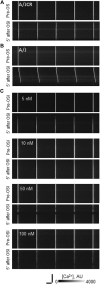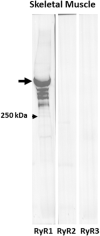Elevated Ca2+ at the triad junction underlies dysregulation of Ca2+ signaling in dysferlin-null skeletal muscle
- PMID: 36406982
- PMCID: PMC9669649
- DOI: 10.3389/fphys.2022.1032447
Elevated Ca2+ at the triad junction underlies dysregulation of Ca2+ signaling in dysferlin-null skeletal muscle
Abstract
Dysferlin-null A/J myofibers generate abnormal Ca2+ transients that are slightly reduced in amplitude compared to controls. These are further reduced in amplitude by hypoosmotic shock and often appear as Ca2+ waves (Lukyanenko et al., J. Physiol., 2017). Ca2+ waves are typically associated with Ca2+-induced Ca2+ release, or CICR, which can be myopathic. We tested the ability of a permeable Ca2+ chelator, BAPTA-AM, to inhibit CICR in injured dysferlin-null fibers and found that 10-50 nM BAPTA-AM suppressed all Ca2+ waves. The same concentrations of BAPTA-AM increased the amplitude of the Ca2+ transient in A/J fibers to wild type levels and protected transients against the loss of amplitude after hypoosmotic shock, as also seen in wild type fibers. Incubation with 10 nM BAPTA-AM led to intracellular BAPTA concentrations of ∼60 nM, as estimated with its fluorescent analog, Fluo-4AM. This should be sufficient to restore intracellular Ca2+ to levels seen in wild type muscle. Fluo-4AM was ∼10-fold less effective than BAPTA-AM, however, consistent with its lower affinity for Ca2+. EGTA, which has an affinity for Ca2+ similar to BAPTA, but with much slower kinetics of binding, was even less potent when introduced as the -AM derivative. By contrast, a dysferlin variant with GCaMP6fu in place of its C2A domain accumulated at triad junctions, like wild type dysferlin, and suppressed all abnormal Ca2+ signaling. GCaMP6fu introduced as a Venus chimera did not accumulate at junctions and failed to suppress abnormal Ca2+ signaling. Our results suggest that leak of Ca2+ into the triad junctional cleft underlies dysregulation of Ca2+ signaling in dysferlin-null myofibers, and that dysferlin's C2A domain suppresses abnormal Ca2+ signaling and protects muscle against injury by binding Ca2+ in the cleft.
Keywords: BAPTA; CICR; Ca-induced Ca release; GCaMP; dysferlinopathy; injury; osmotic shock.
Copyright © 2022 Lukyanenko, Muriel, Garman, Breydo and Bloch.
Conflict of interest statement
LB is employed by Regeneron Pharmaceuticals. The remaining authors declare that the research was conducted in the absence of any commercial or financial relationships that could be construed as a potential conflict of interest.
Figures








Similar articles
-
Nanodysferlins support membrane repair and binding to TRIM72/MG53 but do not localize to t-tubules or stabilize Ca2+ signaling.Mol Ther Methods Clin Dev. 2024 Apr 26;32(2):101257. doi: 10.1016/j.omtm.2024.101257. eCollection 2024 Jun 13. Mol Ther Methods Clin Dev. 2024. PMID: 38779337 Free PMC article.
-
Coupling of excitation to Ca2+ release is modulated by dysferlin.J Physiol. 2017 Aug 1;595(15):5191-5207. doi: 10.1113/JP274515. Epub 2017 Jun 26. J Physiol. 2017. PMID: 28568606 Free PMC article.
-
The C2 domains of dysferlin: roles in membrane localization, Ca2+ signalling and sarcolemmal repair.J Physiol. 2022 Apr;600(8):1953-1968. doi: 10.1113/JP282648. Epub 2022 Mar 8. J Physiol. 2022. PMID: 35156706 Free PMC article.
-
A study of the mechanisms of excitation-contraction coupling in frog skeletal muscle based on measurements of [Ca2+] transients inside the sarcoplasmic reticulum.J Muscle Res Cell Motil. 2018 Apr;39(1-2):41-60. doi: 10.1007/s10974-018-9497-9. Epub 2018 Aug 24. J Muscle Res Cell Motil. 2018. PMID: 30143958 Review.
-
On the role of dysferlin in striated muscle: membrane repair, t-tubules and Ca2+ handling.J Physiol. 2024 May;602(9):1893-1910. doi: 10.1113/JP285103. Epub 2024 Apr 14. J Physiol. 2024. PMID: 38615232 Review.
Cited by
-
Pilot investigations into the mechanistic basis for adverse effects of glucocorticoids in dysferlinopathy.Skelet Muscle. 2024 Aug 9;14(1):19. doi: 10.1186/s13395-024-00350-6. Skelet Muscle. 2024. PMID: 39123261 Free PMC article.
-
Muscle-specific Ryanodine receptor 1 properties underlie limb-girdle muscular dystrophy 2B/R2 progression.Nat Commun. 2025 Mar 28;16(1):3056. doi: 10.1038/s41467-025-58393-2. Nat Commun. 2025. PMID: 40155594 Free PMC article.
-
Utilization of Targeted RNA-Seq for the Resolution of Variant Pathogenicity and Enhancement of Diagnostic Yield in Dysferlinopathy.J Pers Med. 2023 Mar 13;13(3):520. doi: 10.3390/jpm13030520. J Pers Med. 2023. PMID: 36983702 Free PMC article.
-
Nanodysferlins support membrane repair and binding to TRIM72/MG53 but do not localize to t-tubules or stabilize Ca2+ signaling.Mol Ther Methods Clin Dev. 2024 Apr 26;32(2):101257. doi: 10.1016/j.omtm.2024.101257. eCollection 2024 Jun 13. Mol Ther Methods Clin Dev. 2024. PMID: 38779337 Free PMC article.
References
Grants and funding
LinkOut - more resources
Full Text Sources
Research Materials
Miscellaneous

